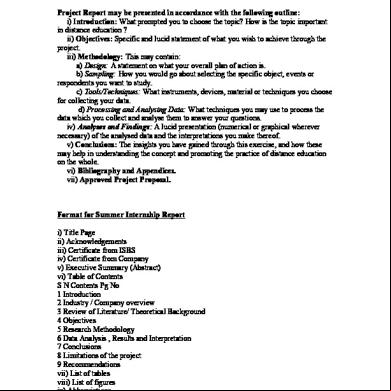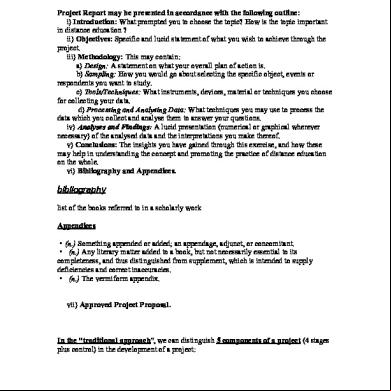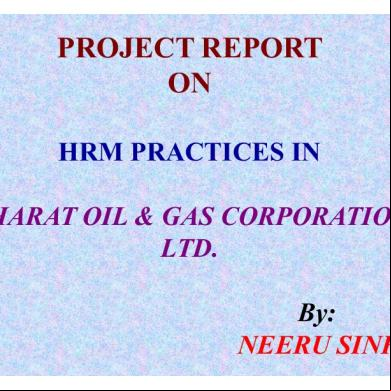Components Of Project Report 1h5f6h
This document was ed by and they confirmed that they have the permission to share it. If you are author or own the copyright of this book, please report to us by using this report form. Report 3i3n4
Overview 26281t
& View Components Of Project Report as PDF for free.
More details 6y5l6z
- Words: 420
- Pages: 2
Components of Project Report Project Report may be presented in accordance with the following outline: i) Introduction: What prompted you to choose the topic? How is the topic important in distance education ? ii) Objectives: Specific and lucid statement of what you wish to achieve through the project. iii) Methodology: This may contain: a) Design: A statement on what your overall plan of action is. b) Sampling: How you would go about selecting the specific object, events or respondents you want to study. c) Tools/Techniques: What instruments, devices, material or techniques you choose for collecting your data. d) Processing and Analysing Data: What techniques you may use to process the data which you collect and analyse them to answer your questions. iv) Analyses and Findings: A lucid presentation (numerical or graphical wherever necessary) of the analysed data and the interpretations you make thereof. v) Conclusions: The insights you have gained through this exercise, and how these may help in understanding the concept and promoting the practice of distance education on the whole. vi) Bibliography and Appendices. vii) Approved Project Proposal.
Format for Summer Internship Report i) Title Page ii) Acknowledgements iii) Certificate from ISBS iv) Certificate from Company v) Executive Summary (Abstract) vi) Table of Contents S N Contents Pg No 1 Introduction 2 Industry / Company overview 3 Review of Literature/ Theoretical Background 4 Objectives 5 Research Methodology 6 Data Analysis , Results and Interpretation 7 Conclusions 8 Limitations of the project 9 Recommendations vii) List of tables viii) List of figures ix) Abbreviations
1. Introduction 1.1. What is the project 1.2. Definition and purpose of the project 1.3. Scope of the project 1.4. Salient Contributions of the project 1.5. Outline of the project report 2. Industry / Company overview 3. Review of Literature/ Theoretical Background 3.1. Theoretical framework, background theory. 3.2. Review of the existing literature from international/ national journals, conferences, books, and reports which are related to the project. 4. Objectives 5. Research Methodology 5.1.1. Method of research 5.1.2. Type of research 5.1.3. Data type 5.1.4. Data Collection tools 5.1.5. Sampling plan 5.1.5.1. Sampling frame 5.1.5.2. Unit 5.1.5.3. Size 5.1.5.4. Method 5.1.6. Data analysis techniques to be used 6. Data Analysis , Results and Interpretation 6.1. Data classification 6.2. Data Analysis and results 6.3. Interpretation of results 7. Conclusions 7.1. Salient conclusions from the work 8. Limitations of the project 9. Recommendations 9.1. Guidelines for the implementation based on conclusions 9.2. Procedure for implementation 9.3. Expected outcome from the recommendations 9.4. Scope for future work Appendix Bibliography
Format for Summer Internship Report i) Title Page ii) Acknowledgements iii) Certificate from ISBS iv) Certificate from Company v) Executive Summary (Abstract) vi) Table of Contents S N Contents Pg No 1 Introduction 2 Industry / Company overview 3 Review of Literature/ Theoretical Background 4 Objectives 5 Research Methodology 6 Data Analysis , Results and Interpretation 7 Conclusions 8 Limitations of the project 9 Recommendations vii) List of tables viii) List of figures ix) Abbreviations
1. Introduction 1.1. What is the project 1.2. Definition and purpose of the project 1.3. Scope of the project 1.4. Salient Contributions of the project 1.5. Outline of the project report 2. Industry / Company overview 3. Review of Literature/ Theoretical Background 3.1. Theoretical framework, background theory. 3.2. Review of the existing literature from international/ national journals, conferences, books, and reports which are related to the project. 4. Objectives 5. Research Methodology 5.1.1. Method of research 5.1.2. Type of research 5.1.3. Data type 5.1.4. Data Collection tools 5.1.5. Sampling plan 5.1.5.1. Sampling frame 5.1.5.2. Unit 5.1.5.3. Size 5.1.5.4. Method 5.1.6. Data analysis techniques to be used 6. Data Analysis , Results and Interpretation 6.1. Data classification 6.2. Data Analysis and results 6.3. Interpretation of results 7. Conclusions 7.1. Salient conclusions from the work 8. Limitations of the project 9. Recommendations 9.1. Guidelines for the implementation based on conclusions 9.2. Procedure for implementation 9.3. Expected outcome from the recommendations 9.4. Scope for future work Appendix Bibliography





